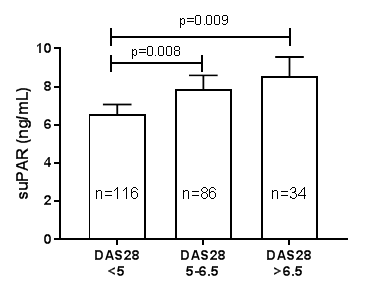Session Information
Date: Sunday, November 5, 2017
Title: Rheumatoid Arthritis – Clinical Aspects Poster I: Treatment Patterns and Response
Session Type: ACR Poster Session A
Session Time: 9:00AM-11:00AM
Background/Purpose:
The urokinase plasminogen activator receptor (uPAR) is expressed on various cell types and plays important roles in proteolysis, migration and adhesion. Receptor shedding yields a soluble form (suPAR) that has been intensively studied as a potential biomarker in several inflammatory diseases and malignancies. The previous few studies on suPAR in rheumatoid arthritis (RA) have shown an association with inflammation and swollen joints, but data on changes in suPAR levels in relation to early disease course are lacking. This study investigates whether suPAR levels predict or reflect disease activity and/or joint damage in early RA.
Methods:
Serum suPAR was measured by ELISA at disease onset (0 months), after 3 months and after 36 months in 252 RA patients from the Swedish early RA cohort TIRA-2. suPAR levels were compared with disease activity (defined by DAS28) and joint damage (Larsen score) at baseline and up to 36 months after disease onset. Healthy individuals (n=100) served as controls.
Results:
Circulating levels of suPAR were higher in RA patients at all three time points compared to healthy controls (mean suPAR = 3.62 ng/mL; p<0.001). The highest suPAR among patients was found at 3 months (mean = 8.47 ng/mL) and the lowest at 36 months (mean = 7.14 ng/mL). suPAR at inclusion correlated with baseline DAS28 (p<0.001, rho=0.25) whereas suPAR levels at 36 months correlated with Larsen score at 36 months (p=0.001, rho=0.24), and 24 months (p=0.002, rho=0.25), but not with DAS28 at any time point. No correlation was found between baseline suPAR and joint damage at any time point. Categorization of baseline DAS28 revealed higher baseline suPAR at high DAS28 (Fig. 1) whereas Larsen score at 36 month reveled higher suPAR (measured at 36 months) among patients with a high score (>5) compared to those with a low score (<2) (Fig. 2).
Conclusion:
suPAR levels associate with disease activity in early untreated RA, but at later stages rather reflect joint damage. Since suPAR levels seem to increase at or after damage accrual, we speculate that suPAR reflects active inflammation and ongoing processes in the joint, rather than being a causative agent.
Figure 1. Serum levels of suPAR and in different categories of disease activity (DAS28) at study inclusion. P-values are from One-way ANOVA with Tukey’s post hoc test. Error bars indicate 95% confidence interval.
Figure 2. Serum levels of suPAR and the degree of joint damage (Larsen score) 36 months after study inclusion. P-values are from One-way ANOVA with Tukey’s post hoc test. Error bars indicate 95% confidence interval.
To cite this abstract in AMA style:
Enocsson H, Kastbom A, Lukic T, Sjöwall C, Skogh T, Wetterö J. Soluble Urokinase Plasminogen Activator Receptor (suPAR) Correlates with Disease Activity in Early Rheumatoid Arthritis and Reflects Joint Damage over Time [abstract]. Arthritis Rheumatol. 2017; 69 (suppl 10). https://acrabstracts.org/abstract/soluble-urokinase-plasminogen-activator-receptor-supar-correlates-with-disease-activity-in-early-rheumatoid-arthritis-and-reflects-joint-damage-over-time/. Accessed .« Back to 2017 ACR/ARHP Annual Meeting
ACR Meeting Abstracts - https://acrabstracts.org/abstract/soluble-urokinase-plasminogen-activator-receptor-supar-correlates-with-disease-activity-in-early-rheumatoid-arthritis-and-reflects-joint-damage-over-time/


